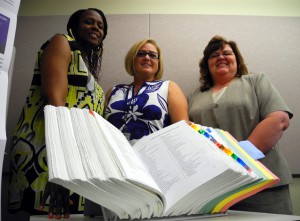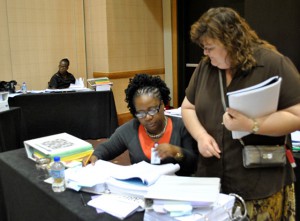Nosologists: What Do They Do and Why Is It Important?
Posted on by
Photo by María-Belén Moran
“How many causes of death are there?” The question makes the experts from the Division of Vital Statistics (DVS) share looks and smiles as they point towards enormous binders. A death certificate often includes a series of conditions that led to the death of an individual. Each condition has a code and is tracked on every single death in the US. This detailed work is collected as part of our national vital registration system.
The mortality data gathered by DVS, National Center for Health Statistics (NCHS), located in Research Triangle Park, NC, through automatic and manual coding, is used for research, health statistics, disease prevention, public health priorities, and resource allocation.
“The coded data needs to be accurate so statisticians can take over, crunch the numbers , and convert them from alphanumeric codes into what becomes national statistics,” said medical classification specialist and senior staff member Tyringa Crawford.
NCHS releases the data in a variety of ways, including published reports, special tabulations to answer data requests, and public-use data sets. The World Health Organization (WHO) compiles mortality statistics for more than 70 countries for publication in the World Health Statistics Annual. The information is useful for a multitude of purposes in studying mortality by location, cause of death, age of death, and circumstances of death.
“The data is used in different ways to analyze the general health situation around the world; to come up with prevention resources. It really does play a huge part of public health, and that is why it is so important for it to be accurate,” said medical classification specialist Celia Dickens.
“When you hear in the news that CDC says that X number of people died last year of cancer, that data came from NCHS, and we put in a lot of effort to provide accurate data,” explained medical classification specialist Holly Lambert.
Training, Experience, and Technology
Mortality medical coders are also known as nosologists. Nosology is a branch of medicine that deals with classification of disease. There are very few mortality coders around the world. “There are a lot of what we call morbidity coders, but mortality is very limited; there are actually very few of us,” said Crawford, who has been part of the World Health Organization-Family of International Classifications (WHO-FIC)’s Education and Implementation Committee that includes both morbidity and mortality coders.
To become a nosologist, the DVS experts said that you need extensive training, to be comfortable using technology, and years of experience searching through coding manuals that are updated annually. “It takes at least an average of five years for a coder to really become competent in what they are doing,” said Dickens.
NCHS has been a worldwide lead in the field of mortality coding. The division continues to develop mechanisms to code data in a more efficient way. One of the newest tools developed by DVS is an online version, similar to an e-book, of the traditional manuals that coders use and that contain the classification structure in the International Classification of Diseases (ICD), published by the World Health Organization (WHO). Manuals can have hundreds of pages, and to facilitate its use they are put into binders and held upright by special racks. During trainings only one person can be seated at a table, due to the space binders and other coding reference materials take up.
In addition to the ICD volumes published by the World Health Organization, the US also maintains an expanded set of volumes that are more detailed and that better reflect codes that are more commonly seen in our country. When you open these manuals, the information looks like entries from a dictionary, each entry with multiple modifiers and subterms. For example, if a person’s death certificate says “bronchial pneumonia,” a nosologist trying to assign the code for the cause of death will open the ICD book and search for the lead term “pneumonia.” Once they find it, the nosologist looks for the subterm, “bronchial” and assigns the code indicated beside the subterm.
“What we do is very detailed; you have to be very meticulous,” said Lambert.
To be able to use these coding manuals correctly, coders need in-depth training. “Quality Data Begins with Quality Training” was the title of a poster presented by the team at a WHO-FIC international conference in 2011. The DVS experts have provided training in the US and abroad and spoken about NCHS training strategies.
“We do minimal basic training now. What we mainly do at this point is provide higher level learning courses that we call Targeted Training Modules,” said Crawford. Initial mandatory courses include Basic Anatomy and Medical Terminology, Introduction to ICD, Basic Underlying Cause of Death and Basic Multiple Cause of Death coding.
In the Basic Underlying Cause of Death course, the coder has to find the one main cause of death that started the whole chain of events that led to the ultimate demise of the individual. For example, if an individual passed away and the death record reported that the person died from cardiac arrest that was due to pneumonia, and the pneumonia was due to lung cancer, the lung cancer was the condition that began the chain-of-events that eventually led to the death. For each death the underlying cause is selected from an array of conditions reported in the medical certification section of the death certificate. This section provides a format for entering the cause of death sequentially. However, the medical certifiers in charge of filling out the certificates do not always follow the sequence of events. Some may write down the conditions in no particular order when they should be entered as one condition causing another, then that condition causing another.
“For Multiple Cause coding, we look at the death record and assign codes for every condition reported. After analyzing everything that is there, seeing how each condition modifies or relates to each other, and applying the rules from the instruction manuals, we are ultimately going to produce one code from that record that we think best represents what started it all—the underlying cause,” explained Crawford.
The multiple cause of death training was originally set up as a 2-week classroom session with daily homework. But when NCHS realized that extended travel and staff absence was costly for state offices and difficult for students who had to be away from home and family, they developed a web-based, self-taught course that covers the more basic instructions that were formerly taught during the first week.
NCHS instructors did a lot of work to convert the first week of the Multiple Cause training into a web-based self-taught course, which saved states time and money by requiring employee(s) to be away from the office for only one week instead of two. It saved hotel, transportation and food costs and valuable employee time in their own office. The training was critical because NCHS only accepted data produced by coders who had successfully completed the rigorous required training to be become a qualified mortality coder, said Crawford.
Beginning in 2011 the coding shifted from state offices to DVS.”We used to receive coded data from the states (and states had varying levels of completion for the data they would provide.) Now we get their death records in an electronic format where it is processed through the automated system and codes that are rejected are manually coded here,” said Crawford.
The decision to have a centralized system was made for many reasons. “For the states it became very hard to keep people in the positions. A lot of the coders were retiring and there was not a lot of people that wanted to take on the amount of time and effort that it takes for that level of training to do this,” said Lambert. “It usually took state employees a year to a year and a half to go through formal training to just begin coding, and then it takes another number of years to become proficient. It is very time-intensive.”
At NCHS a death certificate is a document that receives full attention and respect for the information it can provide for the health and safety of our communities.


Posted on by

